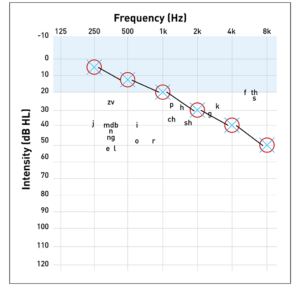When someone tells you your hearing is “normal,” it sounds reassuring — but what does it actually mean? At Rawlings Opticians & Hearing Care, we believe that understanding your hearing health should go beyond the numbers on a chart. One aspect of your hearing appointment is looking at your audiogram – the result generated by This blog will talk about audiograms to explain what “normal” hearing really looks (and sounds!) like.
What is an Audiogram?

An audiogram is the chart used to record the results of your hearing test. It’s a visual map of how well you hear different pitches and volumes — in each ear — and it helps your audiologist build a clear picture of your hearing ability.
The graph shows pitch (frequency, in Hertz) along the bottom and volume (intensity, in decibels) up the side. The higher the mark on the chart, the softer the sound you can hear at that frequency.
Sounds like birdsong and speech live in the higher frequencies, while bass notes and distant thunder are in the lower ones.
What Is Considered “Normal” Hearing?
The term “normal hearing” usually refers to a hearing threshold of 0 to 25 decibels across the speech frequencies (roughly 250 Hz to 8000 Hz). This means you can hear most everyday sounds without strain, including:
- Whispered speech
- Birds tweeting
- A ticking watch
- Distant conversation
In technical terms, if your hearing test shows all your responses within that 0–25 dB range, your hearing is classed as “normal.”
But here’s the catch…
Normal for Age Doesn’t Always Mean Perfect
Just because your hearing falls within the “normal” range doesn’t mean you aren’t experiencing challenges. Many people come to us saying things like:
- “I can hear people, but I can’t understand* them.”
- “I really struggle in restaurants or noisy places.”
- “The TV volume keeps creeping up.”
These issues can still occur even when your audiogram shows “normal” thresholds — especially in complex listening environments where your brain has to work harder to process speech against background noise.
That’s why we always take the time to talk about your lifestyle, any difficulties you’re having, and how your hearing fits into the bigger picture.
Age, Lifestyle and the “Normal” Range
It’s also worth noting that the definition of “normal” is based on a population average. What’s “normal” for a 25-year-old isn’t the same as for a 75-year-old — and vice versa.
So while a result might be considered average for your age group, you might still benefit from support, advice, or hearing care products designed to make life easier and more enjoyable. Think of it like eyesight: even if your vision is technically within a “normal” range, you might still benefit from glasses for driving or reading!
The Importance of Regular Hearing Checks
Hearing loss often happens gradually, so it can be easy to miss. That’s why we recommend regular check-ups — even if you’re not noticing major issues.
At Rawlings, our hearing assessments are thorough, relaxed, and completely free of charge. We’ll explain your results clearly, answer any questions, and work with you to create a plan that fits your lifestyle and hearing goals.
Personalised Care
Your hearing is personal — and so is our care. At Rawlings, we want to help you hear (and feel) your best. Whether you’ve noticed a change or just want to check in, our friendly audiology team is here to support you every step of the way.
Book your free hearing test at your local Rawlings Opticians & Hearing Care branch today.



